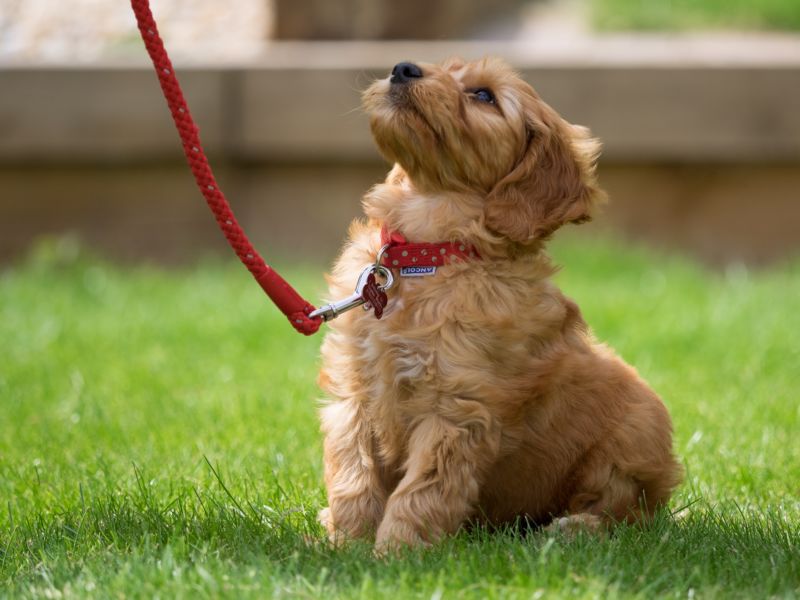
It’s no secret that dogs form strong bonds with their owners; it’s in their nature to do so because they’re pack animals that tend to thrive on love and affection.
While some breeds are much more clingy than others, cockapoos are arguably at the top of the list. After all, they’re primarily bred for companionship. So if you own a cockapoo or are thinking about adopting one, a certain level of clinginess is to be expected.
This doesn’t mean all cockapoos will experience anxiety. But, if they do, we’ve got some tips to help!
Of course, if you think your cockapoo may be experiencing separation anxiety — or is noticeably experiencing it and chewing holes in the wall every time you leave the house — it’s crucial that you learn how to manage the condition appropriately.
It’s not healthy for your pup or good for your home to allow separation anxiety to run rampant. It could lead to serious behavioral issues, plus some costly home repairs.
In this article, we’ll talk about the signs of separation anxiety in cockapoos and how you can help your pup manage it for its overall well-being.
Cockapoo Separation Anxiety: The Signs
It’s important to note that just because cockapoos are considered a clingy breed doesn’t mean all cockapoos will experience separation anxiety. There are also varying levels of separation anxiety, including the less severe separation distress, that can make it easy to overlook the signs and symptoms.
Regardless of your cockapoo’s level of separation anxiety, it’s still unhealthy to allow it to go on, and it may worsen over time if not taken care of.
So, how can you tell if your cockapoo is suffering from separation anxiety?
- You come home to scratch marks on your door and windows.
- They bark and whine excessively or end up in a full-blown panic when you start to leave the house.
- They destroy your home by chewing your furniture, knocking over plants and causing damage to other household items or personal belongings.
- They exhibit regressive behaviors — specifically, having toilet-related accidents inside only when you’re gone.
- They absolutely loathe their crate.
- They start developing bald patches in their fur (due to excessive licking and self-grooming).
- They attempt to stop you from leaving the house by blocking the door, tugging on your clothes, etc.
- Upon your return, they display overexcitement by barking excessively, jumping, running around or having a toilet-related accident.
Keep in mind that your cockapoo may not exhibit all these signs at once. You may notice that they just tend to whine when you’re on your way out the door or target your personal belongings to destroy while you’re gone.
Additionally, not all indoor bathroom accidents are due to separation anxiety. There are actually several common reasons why young and older dogs suddenly start going to the bathroom inside the home. Of course, if your cockapoo is going to the bathroom in the middle of your living room every time you leave the house — and only when you leave the house — it’s a safe bet to assume separation anxiety is at play.

How to Handle Your Cockapoo’s Separation Anxiety
The best way to handle separation anxiety in cockapoos or any breed of dog is preventive training.
Preventive training typically involves crate training and separation training, which begins by leaving your dog in its crate or in a different room for certain periods of time. For example, you’d start by leaving them alone for a half-hour to an hour a day, increasing the time every few days to get them used to being alone. Eventually, you’d move on from leaving the room to leaving the house.
Maybe, your cockapoo is already tearing up the house when you’re gone. Here’s how to remedy the situation:
Make Sure They Have Plenty of Food and Water
Sometimes calming separation anxiety is as simple as ensuring your cockapoo’s basic needs are fulfilled. So make sure your pup always has access to fresh water and food so they have a bit more security.
Of course, food can be a bit tricky. You don’t want to overdo it and end up with an obese dog, and you also don’t want them scarfing down a whole bowl of kibble in one sitting out of fear it won’t be there later. If they don’t have access to go potty while you’re out, you would want to ration the food appropriately.
Your best bet is to invest in an automatic food dispenser with a timer. That way, your cockapoo can stay on a consistent feeding schedule without fear of running out — especially on those days you’re running a bit later than usual.
Create a New “Leaving the House” Routine
Do you have a habit of jingling your keys before leaving? Do you blow your cockapoo kisses and say, “I’ll be back soon, buddy”?
You may not even realize you have a routine for leaving the house, but your cockapoo does and has it memorized. As a result, its separation anxiety could be triggered by each movement that indicates you’re leaving.
Additionally, it begins to look for indicators that you’re returning home, such as the sound of your car in the driveway.
The best thing you can do is vary your leaving and coming home routines as much as possible. That way, you won’t inadvertently trigger your dog’s anxiety because it won’t know which indicators to look for. This will also teach it that your leaving the house is no big deal.
Reward Calm Behavior
Who doesn’t love being greeted excitedly by their pup upon coming home? Unfortunately, entertaining that excitement isn’t doing your cockapoo any favors, especially if it’s jumping and barking excessively when you walk through the door.
As you know, this overexcitement can stem from separation anxiety and will therefore require a little training to help correct the behavior.
The best thing you can do in this case is ignore your cockapoo when you walk through the door. If it jumps on you, simply turn away and keep walking.
Once it calms down — and only then — you’ll want to reward it with praise, pets and treats.
Ignoring bad behavior and rewarding good behavior can be a helpful method of dog training, and in this case, it’ll teach your cockapoo independence as well as how to remain calm.
Invest in Interactive Toys
One thing most people don’t realize is that dogs with higher levels of intelligence tend to be more clingy (not to mention stubborn). However, the higher the intelligence level, the greater the need for social interaction — which is directly related to its need to be regularly stimulated.
Much of your cockapoo’s separation anxiety is coming not from fear but from boredom. When no one’s there to interact with your pup, it might act out destructively.
The best way to keep it mentally stimulated and distracted is by investing in interactive toys, such as puzzle toys that can hold your puppy’s attention for extended periods of time.
For example, frozen treat puzzles are popular because they can distract dogs for hours. Before the dog knows it, hours have passed and you’re home before it even remembers you left in the first place.
Of course, you’ll want to get a few different interactive toys. Otherwise, it’ll get bored quickly and return to gnawing on your personal belongings.
Create a Safe Space
As mentioned earlier, overly clingy cockapoos tend to hate their crates. This is because they associate being put in their crate with their owner leaving.
However, you can flip the script on this one by either turning the crate into a safe space or creating one for your pet elsewhere.
This safe space should be quiet, comfortable and easily accessible. The goal is to get your cockapoo to acknowledge this space as its own, which means once it decides to go there, it’s left alone until it’s ready to interact again.
Having a designated safe space serves as a place your cockapoo can go to when stressed. This will teach it how to self-soothe, which will help it build confidence in confronting stressful situations, such as being left alone.
Leave the TV or Radio On
Having the sound of a human voice or other background noise has proven to be comforting for dogs with separation anxiety. It’ll help your cockapoo feel someone is there with it, and if it’s a dog TV show, it may also help distract it for a while.
DOGTV is a scientifically designed channel for dogs. YouTube also has plenty of channels for your pup.
Take It For a Walk Before You Leave
If you have time, take your cockapoo for a nice calming walk before you leave — and by nice, we mean one that tires it out!
Helping it burn off excess energy before you leave can help keep it relaxed while you’re gone, as it’s beneficial for your pet’s mental health as well as its physical health. Just make sure you follow up the walk with praise and positive reinforcement if it behaves well and calms down once inside.
You’ll also want to remember to vary your walking times so it doesn’t associate each walk with you leaving.

Hire a Dog Walker
If you don’t have time to exercise your cockapoo or you’re going to be gone for longer than it can handle, it might be a good idea to hire a dog walker or pet sitter.
Keep in mind that needing a little extra help doesn’t make you a bad pet parent — it makes you a good one.
Hiring a dog walker to take your cockapoo out for some exercise will help it become more social and less anxious with other people. It’ll likely be taken to a local dog park during this time, which will also help socialize it with other dogs. This is equally important and can improve its overall behavior.
Remember, a separation anxiety-free cockapoo comes with proper training and socialization. As a pet parent, it’s your responsibility to understand and meet your dog’s needs. Of course, if you need a little help, don’t hesitate to reach out to us for advice.
